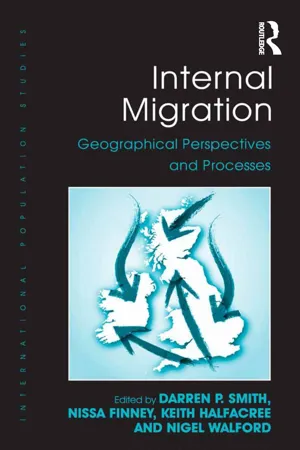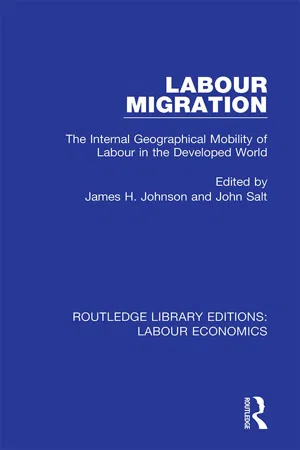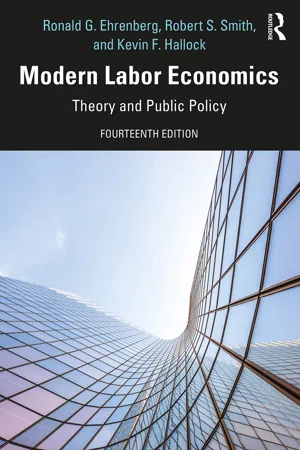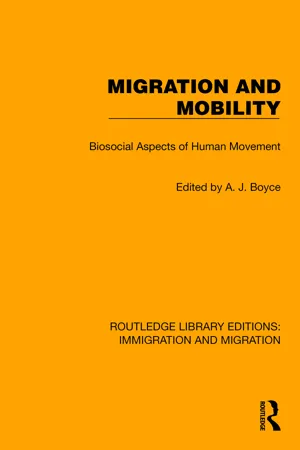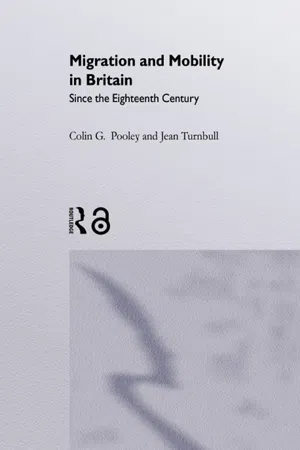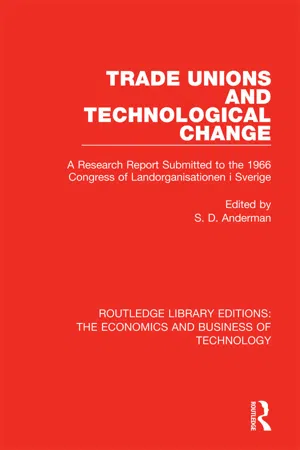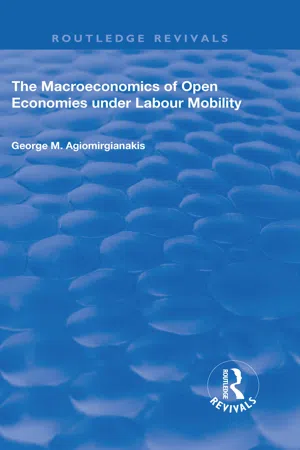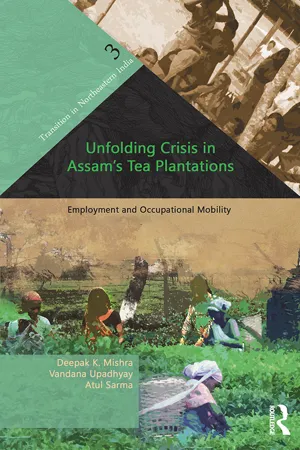Economics
Labour Mobility
Labour mobility refers to the ease with which workers can move between different jobs, occupations, industries, or geographical locations. It is a measure of the flexibility of the labor market and can have significant impacts on employment levels, wages, and overall economic productivity. High levels of labour mobility can lead to a more efficient allocation of resources and a more dynamic economy.
Written by Perlego with AI-assistance
Related key terms
Related key terms
1 of 4
Related key terms
1 of 3
10 Key excerpts on "Labour Mobility"
- eBook - ePub
Internal Migration
Geographical Perspectives and Processes
- Darren P. Smith, Nissa Finney, Nigel Walford(Authors)
- 2016(Publication Date)
- Routledge(Publisher)
While most short distance residential moves are prompted by housing market factors, it is important that due consideration is paid also to the economic and labour market drivers of population mobility. As noted by Fielding (2012), economic drivers typically imply migration for the purpose of accessing employment, or for improved terms and conditions in employment. The neo-classical approach to migration (Boyle, et al., 2008) sees migration as an adjustment mechanism to labour market inequalities and employment. Hence, on the basis of this economic logic, it might be expected that the unemployed would be the most residentially mobile of all groups. Evidence partially confirms this, but the reality is more nuanced: the unemployed do tend to be more residentially mobile than the population groups they tend to be drawn from, but these groups (e.g. people in less skilled manual jobs residing in social housing) are, on average, very spatially immobile (Fielding, 2012).Therefore it is unsurprising that the academic and policy literature has underlined the significance of Labour Mobility (Gordon, 2003). In popular terms this may be seen in terms of people in high unemployment areas ‘getting on their bikes’ and ‘getting on the bus’ (as Government Ministers Norman Tebbit and Iain Duncan Smith urged the unemployed to do in 1981 and 2010, respectively) to take up jobs elsewhere, so adjusting in the face of economic disparities and overcoming social exclusion. Underlying this perspective is the unspoken assumption that spatial mobility is ‘good’ and that the UK economy and society needs more of it. Whilst true in some circumstances, this assumption requires qualification and critical overview. Long commutes, for instance, can be viewed as conflicting with environmental sustainability whilst high levels of ‘population churn’ in some places might disrupt social ties.Labour Mobility has a complex relationship with the economy and wider social dimensions. The economy is subject to short-term business cycle processes, medium-term restructuring processes and long-term ‘deep structural’ changes (Fielding, 2012). These factors influence levels of Labour Mobility on different time scales sometimes in opposing ways. In terms of wider social and demographic dimensions, changes in levels and characteristics of employment by gender – and associated alterations in the shares of two-earner, one-earner and no-earner households – also have implications for Labour Mobility. Likewise developments in transport policy may have significant impacts on employment and there are important interconnections between housing markets and labour markets. - eBook - ePub
Labour Migration
The Internal Geographical Mobility of Labour in the Developed World
- James H. Johnson, John Salt(Authors)
- 2018(Publication Date)
- Routledge(Publisher)
CHAPTER 1Labour Migration: The General ContextJames H. Johnson and John SaltMovements of population may be classified in many ways, since population migration is a complex phenomenon, with many dimensions and causes. Even if attention is focused on those movements which involve a relatively permanent change of home there are different types of migration involved, depending on the reasons for moving. This book is concerned with one broad type of movement - internal labour migration.Population movements which take place within a nation state may be described as ‘internal’. Although in the developed countries of the world it is becoming increasingly difficult to separate internal moves of population from international moves because of the emergence of supra-national economic groupings of states and because of the freer movement of highly specialised workers, it still remains true that the great majority of migrants move within their own countries. In addition, an individual nation continues to provide a distinctive economic and political context for migration.Labour migration consists of those moves of population where a change of residence is accompanied by a change of job. It might be assumed that labour migrants could be defined as those movers who are primarily motivated by job considerations and for many this would be certainly true; but other reasons for moving are also influential for those who are changing both home and job. Labour migration brings a change in the social environment of the people involved and in their housing conditions; it also has implications for the social and economic opportunities available to other members of a migrant’s household. These other factors may dominate the decision of some households to migrate (Johnson, Salt and Wood, 1974). Although there is abundant evidence that the further a migrant moves home the more likely it is that a change of job will also take place, it is better not to prejudge the deeper reasons for moving but simply to employ a definition which merely uses the coincidence of a parallel move of job and home as its basis. - eBook - ePub
Modern Labor Economics
Theory and Public Policy
- Ronald Ehrenberg, Robert Smith, Kevin Hallock(Authors)
- 2021(Publication Date)
- Routledge(Publisher)
worker mobility—the larger category of which immigration is an important subset. Worker mobility plays a critical role in market economies. Because the purpose of any market is to promote voluntary exchange, society relies on the free movement of workers among employers to allocate labor in a way that achieves optimal satisfaction (subject to constraints) for both workers and consumers. The flow (either actual or threatened) of workers from lower-paying to higher-paying jobs, for example, is what forces firms that are paying below-equilibrium wages to increase their wage offers. The existence of compensating wage differentials, to take another example, also depends on the ability of informed workers to exercise choice among employment opportunities in the search for enhanced utility.Mobility, however, is costly. Workers must take time to seek out information on other jobs, and for at least some workers, job search is most efficient if they quit their current job first (to look for work in a new geographic area, for example). Severing ties with the current employer means leaving friends and familiar surroundings, and it may mean giving up valuable employee benefits or the inside track on future promotions.2 Once a new job has been found, workers may well face the monetary, and will almost certainly face the psychic, costs of moving to new surroundings—and in the case of immigration, the possible need to learn a new language and adapt to a new culture makes these costs particularly burdensome. In short, workers who move to new employers bear costs in the near term so that utility can be enhanced later on. Therefore, the human-capital model introduced in Chapter 9 - eBook - ePub
Migration and Mobility
Biosocial Aspects of Human Movement
- A.J. Boyce, A.J. Boyce, A.J. Boyce(Authors)
- 2022(Publication Date)
- Routledge(Publisher)
It is likely, too, that new jobs in manufacturing will be seen as being much less footloose than was thought to be the the case in the past, since in a world competing for jobs, any external economies that can be derived in the economically more attractive locations in Britain may have to be cherished. Hence, there are likely to be greater reservations about relocating jobs from areas of employment surplus to areas of higher unemployment; and labour migration may be required to take a more direct role as a positive instrument in planning policy, since the redistribution of population to take advantage of any available employment opportunities could be of growing importance (Johnson & Salt 1980a). LOCAL LABOUR MARKETS AND MIGRATION Although it is reasonable to assume that much inter-urban migration is accounted for by labour migration, there are important problems involved in the definition of appropriate geographical areas to study its incidence. In reality, what is involved is not population movement among clearly defined urban settlements, but among much vaguer local labour markets. The overall labour market of any country consists of a complex grouping of sub-markets, each centred on a local concentration of jobs. When the idea of a local labour market is translated into real geographical terms it simply implies the area around an employment centre (usually an individual town or city) in which competition for labour normally takes place. Around such an employment centre there will also be an aggregate housing market in which local employees compete for accommodation. At a general level, the local housing and the local labour markets will be similar in extent, with daily journeys to work binding places of residence to places of employment (Johnson et al. 1974a). Unfortunately there are practical and theoretical problems in converting this simple idea into a practical operational tool - eBook - ePub
Integrating Low-Skilled Migrants in the Digital Age: European and US Experience
Conference Proceedings
- Gudrun Biffl (eds.), Philip Martin, , Gudrun Biffl, Philip Martin, Gudrun Biffl, Philip Martin(Authors)
- 2020(Publication Date)
- Edition Donau-Universität Krems(Publisher)
MOBILITY IN LOW-SKILLED LABOR MARKETSThe complex interplay of flexibility and mobility in European labor markets Gudrun BifflIntroductionMobility of low-skilled workers is not only about geographical mobility but also about social mobility and thus the upward mobility in terms of wages and equality of chances in the labor market. Segmented labor markets on the demand side and ‘superdiversity’ of labor on the supply side open up a complex set of opportunities and career paths for low-skilled workers in the various Member States of the European Union (EU-MS). While skilled migrants generally enter the primary labor market, alleviating domestic skill shortages in specific occupations, thus gaining access to the (social) mobility ladder available to natives, low-skilled migrants tend to be relegated to the secondary labor market, with little chance of moving up the occupational and social ladder. Further education and training offer opportunities for low-skilled migrants as well as natives to stay in employment and escape the trap of dead-end jobs, low wages and difficult working conditions.The low-skilled and their mobility in Europe: some facts and figuresThis chapter identifies the level and composition of the low-skilled population in the European Union (EU) by country or region of birth. The focus is on their integration into the labor market, based on labor force participation and unemployment rates.Native and foreign born low-skilled populationIn 2018, some 527 million people lived in the European Economic Area (EEA) and 512 million in the EU28. In the EEA 63.3 million or 12% are foreign born, not dissimilar to the 11.7% in the EU28 (60 million). 65% of the total population were of working age (15-64); of the migrant population (foreign born) a much larger percentage is of working age, namely 78%. This is an indication of labor migration being the main driver of migration, partly for economic reasons promoted by the right to free movement of workers within the EU, partly as a consequence of immigration policy with its focus on labor migration from third countries; family migration is restricted to the partner and dependent children; accordingly, dependent children - but above all older persons - are underrepresented in the migrant population. - Colin Pooley, Jean Turnbull(Authors)
- 2005(Publication Date)
- Routledge(Publisher)
Analysis presented in this chapter has suggested that the relationship between migration and employment is, at different levels, both straightforward and complex. Whilst much migration was to some degree stimulated by the need or desire to change employment, only a relatively small proportion of such moves were clearly related to the economic and labour market characteristics of particular areas. Whereas London did consistently attract labour migrants over long distances, in most other areas labour migration patterns were remarkably similar over both time and space, though specialized labour markets could attract workers over long distances from other areas with similar economic structures. Thus although work could be an important factor in stimulating migration, for most people that stimulus was as likely to come from individual, family life-course and local circumstances. It is very difficult to sustain a convincing argument about consistent links between migration and the relative economic prosperity of particular regions. Employment was a factor which consistently affected migration, but this influence was exercised in a variety of complex ways.For many people the ways in which particular occupations either restricted or provided opportunities for migration were rather more important. Thus in some areas of employment there were strong benefits to be gained from remaining in the same neighbourhood, building up local networks, and exploiting these in the process of career advancement. In other jobs the nature of career progression required mobility and it was necessary to move to a new location to gain relevant experience and career advancement. In this sense the career path that an individual chose also affected their subsequent migration path. Employment could also affect residential decisions in other ways. Opportunities for upward social mobility may have allowed migrants to improve their housing and to move to a better residential area, whilst other jobs required employees to live close to their workplace and thus constrained the journey to work and residential location.In most households migration decisions related to employment opportunities were taken to benefit the career of a male household head, or possibly to provide opportunities for male children. Female household members often had to fit their careers around such moves and hence women were much more likely to enter or leave the labour market following migration. However, it is clear from the individual case studies in particular that migration for employment reasons was often closely intertwined with movement stimulated by other factors. Although job-related movement was the single largest category, migration for housing improvement, marriage, family reasons and as a response to crises were all important and may have disproportionately affected women and children. Subsequent chapters will examine the pattern and process of migration for this wider range of reasons in much more detail.- eBook - ePub
Trade Unions and Technological Change
A Research Report Submitted to the 1966 Congress of Landsorganistionen i Sverige
- Steven Anderman(Author)
- 2018(Publication Date)
- Routledge(Publisher)
CHAPTER 8Labour Mobility
The advance of technology in post-war Sweden has taken place in a labour market characterized by a manpower scarcity of hitherto unknown severity. The projections of the Long-term Planning Commission for the period 1965–80 indicate that this shortage of labour will continue and probably intensify. Registered unemployment has been exceedingly low, apart from that in several occupations highly susceptible to seasonal fluctuations and in a few isolated regions, though of course when the aggregate figure is broken down by industry and sub-industrial sector, we obtain a more varied picture. The highly diversified economic development, with considerable expansion in some industries and stagnation or contraction in others, reflects the process of dynamic growth working its way throughout the economy.It is no more than an assumption, however, that this process will accelerate in the future. Indeed, if we view it in a historical perspective, the acceleration hypothesis is somewhat dubious. The transformation of the rural society and the household production and consumption patterns of the pre-industrial economy into the production apparatus and market economy of an industrialized society was a lengthy process. Its earlier stages were marked by events of greater dramatic impact and repercussions for many more people than technological change has had in recent years. The enormous wave of emigration that swept through Sweden in the latter half of the past century was a symptom of the abject failure of society at that time to master its economic and social problems. The crucial difference between the present situation and conditions seventy-five years ago is that expanding sectors in today’s economy are capable of absorbing manpower at a rate commensurate with the growth in the labour force and redundancies in the contracting sectors. Another important difference is that the personal difficulties for an individual adjusting from a rural to an industrialized job environment are probably greater than the problems involved in the transfer from one industry to another. - George M Agiomirgianakis(Author)
- 2019(Publication Date)
- Routledge(Publisher)
1 International Mobility of Labour and Monetary Policy in a Small Open Economy1 Introduction
Most of the existing literature on international Labour Mobility (ILM) deals with either the causes of Labour Mobility or the ‘welfare effects’ of Labour Mobility, that is, the question of whether international mobility of labour will depress the wages of the host country or whether there will be some benefit for the sending country (see, for example, Greenwood, 1969; Djajic, 1985; Rivera-Batiz, 1989; Quibria, 1989; Brecher and Choudhri, 1987, 1990; Abowd and Freeman, 1991; Borjas and Freeman, 1992; Nikas, 1992; Ichino, 1993; De New and Zimmerman, 1993a and b; Freeman, 1993). This literature often relies on ad hoc assumptions regarding the workers motives for moving from one job to another: authors either incorporate in their analysis several social and economic variables (gravity models) (see e.g. Greenwood, 1969; Stark, 1991; Abowd and Freeman, 1991; Zimmermann, 1992; Faini and Venturini, 1993; Vijverberg, 1993) or employ models which are based on the assumption that Labour Mobility depends upon expected real income differences (see e.g. Rodriguez, 1976; Djajic, 1989; Borjas, 1991; Stark, 1991; Burda and Wyplosz, 1992, 1993; Baldwin and Venables, 1993; Dolado, 1993). Moreover, none of these studies has incorporated the possibility of international Labour Mobility into a macroeconomic framework.The purpose of this chapter is to incorporate the possibility of international Labour Mobility into a macro model of a small open economy with a flexible exchange rate and a competitive labour market and explore its role in the adjustment of the economy to monetary-policy changes. While the bulk of the literature on exchange rate dynamics assumes capital mobility, most studies make the assumption of no international mobility of labour (see e.g. Dornbush, 1976; Sachs, 1980; Driskill and McCafferty, 1987; Ahtiala, 1989; Devereux and Purvis, 1990). This chapter can be viewed as an attempt to extend the international macroeconomics literature by taking account of the possibility of international Labour Mobility. Indeed, two issues are addressed: first, what are the macroeconomic implications of monetary expansions under ILM; and, second, how the presence of ILM affects exchange-rate variability following unanticipated monetary shocks.- eBook - ePub
Divisions and Solidarities
Gender, Class and Employment in Latin America
- Alison MacEwen Scott(Author)
- 2005(Publication Date)
- Routledge(Publisher)
Appendix ). In brief, a ‘job change’ was considered to have occurred whenever there was a change in (a) the trade or occupation, (b) the skill level of a job, (c) the employment status, or (d) the enterprise. Changes in labour force status, such as unemployment, withdrawal for full-time housework, military service, illness etc., were also regarded as breaks in employment. This definition tends to produce a higher number of changes than many datasets which only record occupational or employer changes.Mobility variables are also affected by how first entry into the labour market is defined. This is problematic in Peru because of the prevalence of child labour. As indicated in previous chapters, many children, especially migrants, started work at an early age. Therefore the practice in Peruvian official statistics of defining entry at the age of 14 years was inappropriate in my view. In this study, child labour was coded as a job and incorporated into the mobility analysis.2FIRST ENTRY INTO THE LABOUR MARKETInformal sector theory assumes that migrants are engaged in agricultural work prior to migration and enter the tertiary sector immediately after their arrival in the city. Access to manufacturing jobs is only possible after a period of time there. The Lima data show that this picture was true for women but not men. Although most migrants came from an agricultural background, migrant men had experience of manufacturing and formal sector employment both prior to migration and on arrival in the city, in fact more so than the Lima-born. Migrant women, on the other hand, were more likely to go straight into domestic service in the city.As chapter 4 showed, the labouring class had a strong migrant/agricultural background. About three-quarters of them were migrants and nearly half were from peasant families. Just over a third of informants’ fathers and over half of their mothers were in agriculture at the point when they entered the labour force.3 Child labour was important amongst most of the migrants, especially boys,4 - eBook - ePub
Unfolding Crisis in Assam's Tea Plantations
Employment and Occupational Mobility
- Deepak K. Mishra, Vandana Upadhyay, Atul Sarma(Authors)
- 2014(Publication Date)
- Routledge India(Publisher)
5 Causes and Implications of Occupational MobilityShifting of labour, from one occupation to another, is a result of both push and pull factors of various kinds. The relative importance of the various factors is difficult to ascertain because of the simultaneous existence of various forces that prompt the individual or the household for the occupational shift. However, while there is considerable evidence in the literature that expected or actual levels of income play a prominent role in the decision making about occupational change, there are a host of other variables which influence an individual’s choices. We attempted to identify a few factors that influence occupational diversification in the previous chapter. In this chapter we carry forward the analysis, by focusing on the perception of the workers with regard to occupational change and diversification. This discussion is supplemented by a discussion of the factors encouraging or discouraging the workers to move out of the tea sector.Perceptions on Working Conditions and Occupational ChangeWorkers’ perception on their working conditions and the desire to change occupations provide important insights regarding the conditions of work inside and outside the gardens. However, an analysis of perceptions through a questionnaire method has some inherent limitations.1 Respondents may not be willing to share their real perceptions with the interviewer for a number of reasons. Moreover, such revealed perceptions recorded with reference to hypothetical situations may not reflect the real choices opted for in concrete situations. Although all possible steps were taken to minimise the errors and misreporting on these counts, still the results are, to some extent, influenced by these factors.Among all categories of workers within the gardens, dissatisfaction with working conditions was highest among the casual tea garden workers and those engaged in trade and business. Over all, an overwhelmingly large number of workers have reported to be satisfied with their working conditions (Table 5.1 ). Outside, the garden, workers were found to be more ambiguous and less satisfied with their working conditions. Those who were found to be most dissatisfied with their working conditions include private salaried employees, non-farm casual worker and agricultural labourers (Table 5.2 ). Interestingly, casual tea garden workers outside the gardens are less dissatisfied about their working conditions than their counterparts inside the gardens. Among those who stay outside the gardens, nearly 4 per cent have reported that the shift to their own occupation was not voluntary (Table 5.3 ). To delve further into the perceptions of those who live outside the garden, their views with respect to the tea gardens have been presented in Table 5.4
Index pages curate the most relevant extracts from our library of academic textbooks. They’ve been created using an in-house natural language model (NLM), each adding context and meaning to key research topics.
Explore more topic indexes
Explore more topic indexes
1 of 6
Explore more topic indexes
1 of 4
